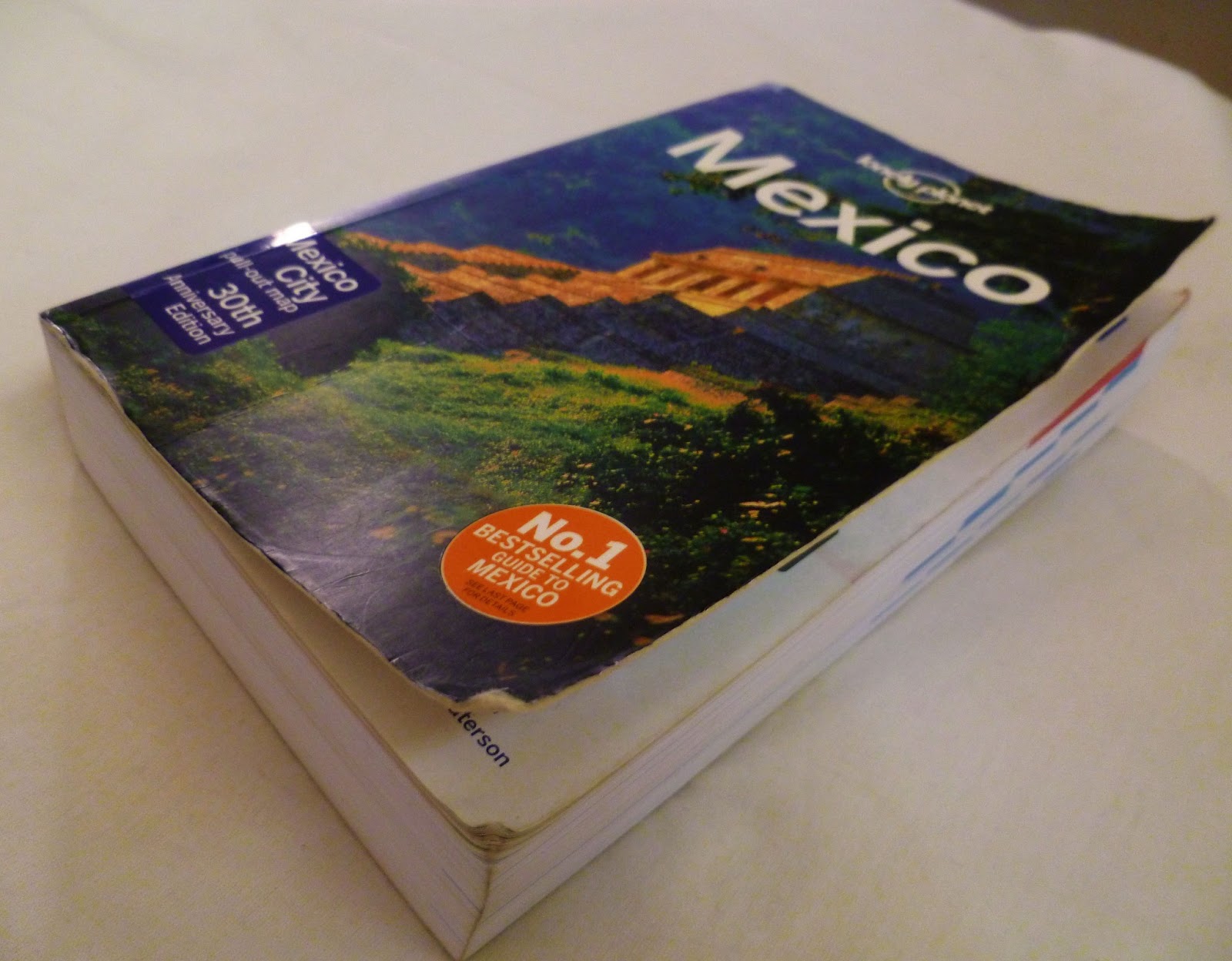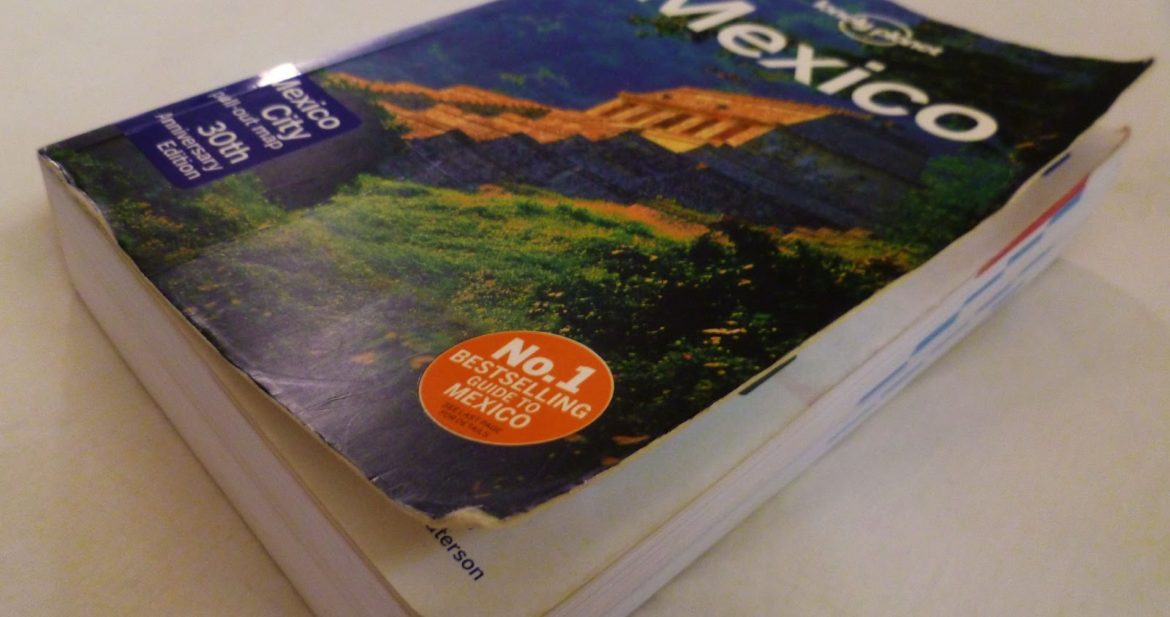
After several screwy experiences and feeling pretty ripped off over the price of the actual book itself, I have decided that I may never purchase a physical guide book again.
Reading blog posts like this one at Runaway Juno also compounded this feeling, so much so that I had to share my own fairly negative experiences in using them.
On previous trips I had never even given it a second thought. I would book my flights and my accommodation, and then I would head out excitedly to my nearest bookstore and purchase a guide book to said destination, pouring over it for the whole run-up to my departure.
For my current round-the-world trip, I have only purchased two guide books. One was for New Zealand which I downloaded on my Kindle last year (worst idea ever – trying to flick back and forth between destinations on a Kindle is less than ideal) and the second was a Lonely Planet purchased just two months ago for my current stint in Mexico.
The book is the latest edition of the Mexico guide (published in September 2012) i.e. we couldn’t have got a more up-to-date version of this guide if we had wanted to. Having looked at the Lonely Planet website, it would appear that another edition is not due to be published until September 2014 – therefore all of the information in this book has to cover two years of Mexico travel.
And yet, most of the advice we have taken from it, just seven months after it was published, has been incorrect and out of date.
Now, before I go any further, let me just say that I realise that any kind of publication is never going to be perfectly accurate in its numbers, especially with something which takes so long to produce.
But, when some travellers rely solely on guide books to get them through their trips, it is sad to see so many things go wrong. Here’s why I now prefer blogs over guide books.
Wrong Pricing
On at least two occasions in Mexico we have arrived at Mayan ruins expecting to pay a certain price for admission as advised in our Lonely Planet guide. On all occasions the prices have been off by at least 7 Pesos. Now, this amount is hardly groundbreaking (around 50 cents/person) but some people stick to extremely tight budgets, especially when travelling in a group or as a family. And considering considering 7 Pesos is the average price of a street taco, this is a considerable rise by Mexican standards.
The closing times for all ruins, as set out in the guide book, were also wrong. As was the street address for the collectivo taxi stand in one town.
On our visit to the ruins at Palenque, we had read in our guide book that we would be required to pay a fee to enter the National Park the ruins are situated within (in addition to the entrance fee for the ruins). We did, and we got a nice colourful wristband to show for it.
Then we got home that evening and read one of our fellow bloggers’ sites about the same ruins and discovered that there is no obligation to pay the entrance fee to the National Park, but more that it’s a “suggested donation”. It would have been nice to know that before we forked out $4 we didn’t need to. Shame I didn’t stumble upon that blog earlier. But that begs the question – why did the guide book not inform us of this fact?
Blogs Are Date-Stamped
One reason I love blogs so much is that, even in this world of ever-changing information and pricing, blogs are usually date-stamped, meaning that you can tell how recent the article is you are reading.
If you’re reading a blog about your destination which was written in the same month in which you’re visiting, then it’s highly likely that that information is going to be more correct than that of a book which may have hit the editors or the printers a whole year before.
Everything Is About Personality
No two people ever have the same experience in one place. It is also likely that many people will not like one hotel or restaurant but others will love it.
Why is it that we take the opinion of the authors of these major guide books above all else? We have never met these people. We do not know their interests or their tastes. We don’t know how comfortable they like their hotel rooms to be or how they like their food cooked.
And yet, if somewhere is listed in a Lonely Planet/Rough Guides/Frommers, people flock there without a second thought.
With blogs, you can get a true sense of someone’s personality by reading their writing. If you don’t feel as though you are the same “fit” personality-wise, then you probably wouldn’t take their advice on where to eat or what attractions to visit.
Likewise, some bloggers may feel as though they could be old friends, such does their travelling style seem to be similar to your own. In that way, you are more likely to want to take their recommendations on things they have seen and done.
Popularity Isn’t Always A Good Thing
One night in San Cristobal de las Casas, we visited a restaurant listed in our Lonely Planet, simply off the description alone. We had to go and hunt this place out, so having never seen it with our own eyes, we had been unable to make any snap decisions beforehand.
The opening time as listed in the guide book was wrong (surprise, surprise) but luckily there was a worker opening the door to the kitchen as we arrived, who told us to come back in an hour.
We did, and the place was full to bursting.
People were stood waiting for tables, tourists kept flooding in clutching their Lonely Planet guidebooks, obviously all following the same recommendation as us.
The worst part? I had a feeling that this restaurant had only just been listed in the most recent edition of the book and thus the staff and owners just couldn’t keep up with new demand. None of them spoke any English (which is fair enough, this being a Spanish-speaking country, but it seemed to be causing them a bit of a problem now that LP was sending so many foreign tourists there) and there just wasn’t enough space in the restaurant or food on the grill to keep up with demand.
After being there two hours and only receiving half of our original order, I was told that one of the items I had ordered had sold out. Two hours after I had first ordered it, when there had been plenty.
They quickly made me an alternative (which I suspect was re-heated meat – all they had left) that I didn’t really want, but I ate it as I was so hungry. The next day I got sick.
Now, of course, this is not the fault of Lonely Planet. The poor people at the restaurant were struggling to cope with their new-found fame.
But it just goes to show how the opinion of one person (i.e. the writer of that particular section of the book, who must have enjoyed a visit to said restaurant in the past, pre-guide book fame) had so greatly affected this business. And for me, not in a good way. I went away having had a less-than-pleasurable experience and would probably never go back.
Personal Preferences and Fact Checking
After all of this ranting, I guess what I’m trying to say is that guide books are great in giving you a general overview of a place and which particular towns or destinations you may want to visit. But you must take everything they say with a grain of salt. Everything in a guide book has been written by someone with certain preferences and opinions, and they may not align with your own.
As for the prices and opening times, all I can say is just to double-check your facts online before you go (with the most up-to-date source you can, or at least someone/a blogger you trust). I wish I had taken that advice, and won’t be making the same mistake again.

Leave a Reply